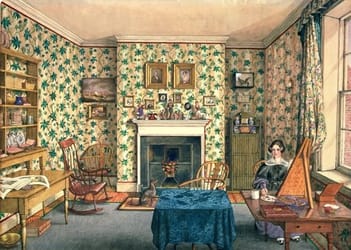

Self Portrait in Painting Room, York, 1837-1839
Mary Ellen Best
At about age 50, Mary Ellen Best (1809–1891), a middle-class British woman, gathered images of her private life that she had painted over a 35-year period and placed them into albums organized chronologically. Necessarily, this process would have been a selective one. Best would have chosen images that corresponded to her inner narrative of self—an intricate interweaving of societal expectations based on her class, race, and gender as well as her own mediation of such norms. Indeed, as Best's albums imply, subjectivity is hardly stable and cohesive; it is more often fractured and disjunctive, historically constructed in and through prescriptive discourses. Though individuals can assume conflicting subjectivities at various moments or even concurrently, Best's albums indicate that the simultaneous roles of middle-class housewife and female artist were not viable ones for her. If, as Abigail Solomon-Godeau suggests, we must attend carefully to the self-representations of 19th-century women, we do well to examine Best's construction of a visual autobiography for what it reveals about the difficult choices faced by middle-class female artists during the early years of the Victorian period.
...Best returned to York in August 1835, and after the death of her mother in 1837 she painted two self-portraits that are the most overt indications of her self-identification as an artist before her marriage. In one, completed between 1837 and 1839, Best depicts herself in her painting room at York. Although she rented the entire house and lived there alone, this room was devoted to her artistic pursuits, indicating that painting was a central aspect of her identity. The picture is painted in exquisite detail and reveals the space as a well-ordered domestic one. A covering protects the carpet and the only note of disarray is confined to the left corner, where prints are scattered haphazardly on a table—a foreshadowing of her difficulty reconciling her artistic life with her domestic one. Above the fireplace are portraits of her parents that she painted, as well as sketches of other family members. The other images in the room appear to be still lifes and nature scenes that are probably her own work. Her choice of paintings reveals both her closeness to her family and the importance of her artistic pursuits. She depicts herself by the window, dressed in mourning for her mother. Arranged on the table before her are the accoutrements that identify her as an artist: an easel, box of tablets, palette, water mug, and leather-bound portfolio. The fact that she is looking directly at the viewer is unusual in her work; that she does so as an artist is telling. Indeed, few female artists in Best's position identified themselves so readily with the artistic role. Jemima Blackburn, a Scottish artist of the same period who was much more successful in negotiating her position between professional and amateur, never presented herself as an artist so boldly. Though Blackburn was nationally recognized for her ornithological drawings and prints, she typically produced only modest images of herself at work. In these, she shows herself drawing or painting, but does not directly address the viewer....
[http://www.19thc-artworldwide.org/spring05/82-autumn02/autumn02article/261-negotiating-identity-mary-ellen-best-and-the-status-of-female-victorian-artists]
Uploaded on Apr 5, 2018 by Suzan Hamer
Mary Ellen Best
artistArthur
Wait what?


